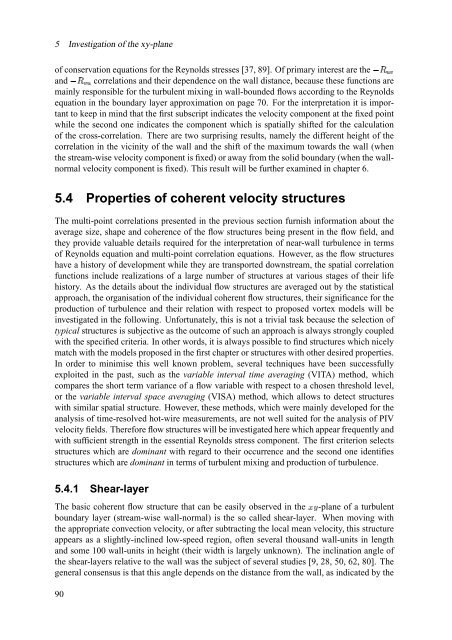The significance of coherent flow structures for the turbulent mixing ...
The significance of coherent flow structures for the turbulent mixing ...
The significance of coherent flow structures for the turbulent mixing ...
Create successful ePaper yourself
Turn your PDF publications into a flip-book with our unique Google optimized e-Paper software.
5 Investigation <strong>of</strong> <strong>the</strong> xy-plane<br />
<strong>of</strong> conservation equations <strong>for</strong> <strong>the</strong> Reynolds stresses [37, 89]. Of primary interest are ÎV¼ÐÏ'Ñ <strong>the</strong><br />
ÎмÐÑÏ and correlations and <strong>the</strong>ir dependence on <strong>the</strong> wall distance, because <strong>the</strong>se functions are<br />
mainly responsible <strong>for</strong> <strong>the</strong> <strong>turbulent</strong> <strong>mixing</strong> in wall-bounded <strong>flow</strong>s according to <strong>the</strong> Reynolds<br />
equation in <strong>the</strong> boundary layer approximation on page 70. For <strong>the</strong> interpretation it is important<br />
to keep in mind that <strong>the</strong> first subscript indicates <strong>the</strong> velocity component at <strong>the</strong> fixed point<br />
while <strong>the</strong> second one indicates <strong>the</strong> component which is spatially shifted <strong>for</strong> <strong>the</strong> calculation<br />
<strong>of</strong> <strong>the</strong> cross-correlation. <strong>The</strong>re are two surprising results, namely <strong>the</strong> different height <strong>of</strong> <strong>the</strong><br />
correlation in <strong>the</strong> vicinity <strong>of</strong> <strong>the</strong> wall and <strong>the</strong> shift <strong>of</strong> <strong>the</strong> maximum towards <strong>the</strong> wall (when<br />
<strong>the</strong> stream-wise velocity component is fixed) or away from <strong>the</strong> solid boundary (when <strong>the</strong> wallnormal<br />
velocity component is fixed). This result will be fur<strong>the</strong>r examined in chapter 6.<br />
5.4 Properties <strong>of</strong> <strong>coherent</strong> velocity <strong>structures</strong><br />
<strong>The</strong> multi-point correlations presented in <strong>the</strong> previous section furnish in<strong>for</strong>mation about <strong>the</strong><br />
average size, shape and coherence <strong>of</strong> <strong>the</strong> <strong>flow</strong> <strong>structures</strong> being present in <strong>the</strong> <strong>flow</strong> field, and<br />
<strong>the</strong>y provide valuable details required <strong>for</strong> <strong>the</strong> interpretation <strong>of</strong> near-wall turbulence in terms<br />
<strong>of</strong> Reynolds equation and multi-point correlation equations. However, as <strong>the</strong> <strong>flow</strong> <strong>structures</strong><br />
have a history <strong>of</strong> development while <strong>the</strong>y are transported downstream, <strong>the</strong> spatial correlation<br />
functions include realizations <strong>of</strong> a large number <strong>of</strong> <strong>structures</strong> at various stages <strong>of</strong> <strong>the</strong>ir life<br />
history. As <strong>the</strong> details about <strong>the</strong> individual <strong>flow</strong> <strong>structures</strong> are averaged out by <strong>the</strong> statistical<br />
approach, <strong>the</strong> organisation <strong>of</strong> <strong>the</strong> individual <strong>coherent</strong> <strong>flow</strong> <strong>structures</strong>, <strong>the</strong>ir <strong>significance</strong> <strong>for</strong> <strong>the</strong><br />
production <strong>of</strong> turbulence and <strong>the</strong>ir relation with respect to proposed vortex models will be<br />
investigated in <strong>the</strong> following. Un<strong>for</strong>tunately, this is not a trivial task because <strong>the</strong> selection <strong>of</strong><br />
typical <strong>structures</strong> is subjective as <strong>the</strong> outcome <strong>of</strong> such an approach is always strongly coupled<br />
with <strong>the</strong> specified criteria. In o<strong>the</strong>r words, it is always possible to find <strong>structures</strong> which nicely<br />
match with <strong>the</strong> models proposed in <strong>the</strong> first chapter or <strong>structures</strong> with o<strong>the</strong>r desired properties.<br />
In order to minimise this well known problem, several techniques have been successfully<br />
exploited in <strong>the</strong> past, such as <strong>the</strong> variable interval time averaging (VITA) method, which<br />
compares <strong>the</strong> short term variance <strong>of</strong> a <strong>flow</strong> variable with respect to a chosen threshold level,<br />
or <strong>the</strong> variable interval space averaging (VISA) method, which allows to detect <strong>structures</strong><br />
with similar spatial structure. However, <strong>the</strong>se methods, which were mainly developed <strong>for</strong> <strong>the</strong><br />
analysis <strong>of</strong> time-resolved hot-wire measurements, are not well suited <strong>for</strong> <strong>the</strong> analysis <strong>of</strong> PIV<br />
velocity fields. <strong>The</strong>re<strong>for</strong>e <strong>flow</strong> <strong>structures</strong> will be investigated here which appear frequently and<br />
with sufficient strength in <strong>the</strong> essential Reynolds stress component. <strong>The</strong> first criterion selects<br />
<strong>structures</strong> which are dominant with regard to <strong>the</strong>ir occurrence and <strong>the</strong> second one identifies<br />
<strong>structures</strong> which are dominant in terms <strong>of</strong> <strong>turbulent</strong> <strong>mixing</strong> and production <strong>of</strong> turbulence.<br />
5.4.1 Shear-layer<br />
<strong>The</strong> basic <strong>coherent</strong> <strong>flow</strong> structure that can be easily observed in <strong>the</strong> áEÄ -plane <strong>of</strong> a <strong>turbulent</strong><br />
boundary layer (stream-wise wall-normal) is <strong>the</strong> so called shear-layer. When moving with<br />
<strong>the</strong> appropriate convection velocity, or after subtracting <strong>the</strong> local mean velocity, this structure<br />
appears as a slightly-inclined low-speed region, <strong>of</strong>ten several thousand wall-units in length<br />
and some 100 wall-units in height (<strong>the</strong>ir width is largely unknown). <strong>The</strong> inclination angle <strong>of</strong><br />
<strong>the</strong> shear-layers relative to <strong>the</strong> wall was <strong>the</strong> subject <strong>of</strong> several studies [9, 28, 50, 62, 80]. <strong>The</strong><br />
general consensus is that this angle depends on <strong>the</strong> distance from <strong>the</strong> wall, as indicated by <strong>the</strong><br />
90
















